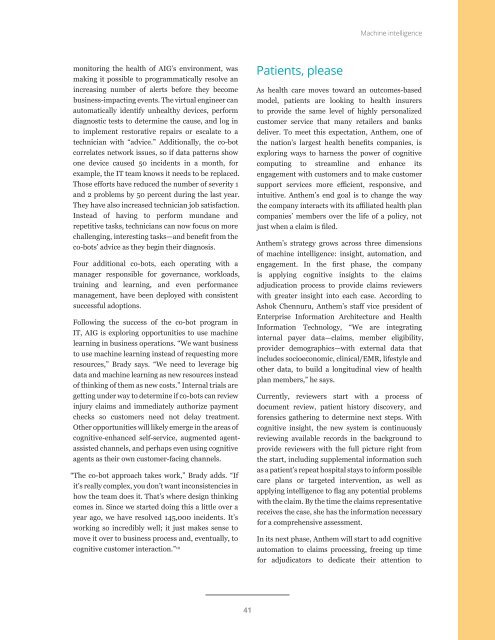Trending the trends Eight years of research
2kcf8xh
2kcf8xh
Create successful ePaper yourself
Turn your PDF publications into a flip-book with our unique Google optimized e-Paper software.
Machine intelligence<br />
monitoring <strong>the</strong> health <strong>of</strong> AIG’s environment, was<br />
making it possible to programmatically resolve an<br />
increasing number <strong>of</strong> alerts before <strong>the</strong>y become<br />
business-impacting events. The virtual engineer can<br />
automatically identify unhealthy devices, perform<br />
diagnostic tests to determine <strong>the</strong> cause, and log in<br />
to implement restorative repairs or escalate to a<br />
technician with “advice.” Additionally, <strong>the</strong> co-bot<br />
correlates network issues, so if data patterns show<br />
one device caused 50 incidents in a month, for<br />
example, <strong>the</strong> IT team knows it needs to be replaced.<br />
Those efforts have reduced <strong>the</strong> number <strong>of</strong> severity 1<br />
and 2 problems by 50 percent during <strong>the</strong> last year.<br />
They have also increased technician job satisfaction.<br />
Instead <strong>of</strong> having to perform mundane and<br />
repetitive tasks, technicians can now focus on more<br />
challenging, interesting tasks—and benefit from <strong>the</strong><br />
co-bots’ advice as <strong>the</strong>y begin <strong>the</strong>ir diagnosis.<br />
Four additional co-bots, each operating with a<br />
manager responsible for governance, workloads,<br />
training and learning, and even performance<br />
management, have been deployed with consistent<br />
successful adoptions.<br />
Following <strong>the</strong> success <strong>of</strong> <strong>the</strong> co-bot program in<br />
IT, AIG is exploring opportunities to use machine<br />
learning in business operations. “We want business<br />
to use machine learning instead <strong>of</strong> requesting more<br />
resources,” Brady says. “We need to leverage big<br />
data and machine learning as new resources instead<br />
<strong>of</strong> thinking <strong>of</strong> <strong>the</strong>m as new costs.” Internal trials are<br />
getting under way to determine if co-bots can review<br />
injury claims and immediately authorize payment<br />
checks so customers need not delay treatment.<br />
O<strong>the</strong>r opportunities will likely emerge in <strong>the</strong> areas <strong>of</strong><br />
cognitive-enhanced self-service, augmented agentassisted<br />
channels, and perhaps even using cognitive<br />
agents as <strong>the</strong>ir own customer-facing channels.<br />
“The co-bot approach takes work,” Brady adds. “If<br />
it’s really complex, you don’t want inconsistencies in<br />
how <strong>the</strong> team does it. That’s where design thinking<br />
comes in. Since we started doing this a little over a<br />
year ago, we have resolved 145,000 incidents. It’s<br />
working so incredibly well; it just makes sense to<br />
move it over to business process and, eventually, to<br />
cognitive customer interaction.” 12<br />
Patients, please<br />
As health care moves toward an outcomes-based<br />
model, patients are looking to health insurers<br />
to provide <strong>the</strong> same level <strong>of</strong> highly personalized<br />
customer service that many retailers and banks<br />
deliver. To meet this expectation, An<strong>the</strong>m, one <strong>of</strong><br />
<strong>the</strong> nation’s largest health benefits companies, is<br />
exploring ways to harness <strong>the</strong> power <strong>of</strong> cognitive<br />
computing to streamline and enhance its<br />
engagement with customers and to make customer<br />
support services more efficient, responsive, and<br />
intuitive. An<strong>the</strong>m’s end goal is to change <strong>the</strong> way<br />
<strong>the</strong> company interacts with its affiliated health plan<br />
companies’ members over <strong>the</strong> life <strong>of</strong> a policy, not<br />
just when a claim is filed.<br />
An<strong>the</strong>m’s strategy grows across three dimensions<br />
<strong>of</strong> machine intelligence: insight, automation, and<br />
engagement. In <strong>the</strong> first phase, <strong>the</strong> company<br />
is applying cognitive insights to <strong>the</strong> claims<br />
adjudication process to provide claims reviewers<br />
with greater insight into each case. According to<br />
Ashok Chennuru, An<strong>the</strong>m’s staff vice president <strong>of</strong><br />
Enterprise Information Architecture and Health<br />
Information Technology, “We are integrating<br />
internal payer data—claims, member eligibility,<br />
provider demographics—with external data that<br />
includes socioeconomic, clinical/EMR, lifestyle and<br />
o<strong>the</strong>r data, to build a longitudinal view <strong>of</strong> health<br />
plan members,” he says.<br />
Currently, reviewers start with a process <strong>of</strong><br />
document review, patient history discovery, and<br />
forensics ga<strong>the</strong>ring to determine next steps. With<br />
cognitive insight, <strong>the</strong> new system is continuously<br />
reviewing available records in <strong>the</strong> background to<br />
provide reviewers with <strong>the</strong> full picture right from<br />
<strong>the</strong> start, including supplemental information such<br />
as a patient’s repeat hospital stays to inform possible<br />
care plans or targeted intervention, as well as<br />
applying intelligence to flag any potential problems<br />
with <strong>the</strong> claim. By <strong>the</strong> time <strong>the</strong> claims representative<br />
receives <strong>the</strong> case, she has <strong>the</strong> information necessary<br />
for a comprehensive assessment.<br />
In its next phase, An<strong>the</strong>m will start to add cognitive<br />
automation to claims processing, freeing up time<br />
for adjudicators to dedicate <strong>the</strong>ir attention to<br />
41


